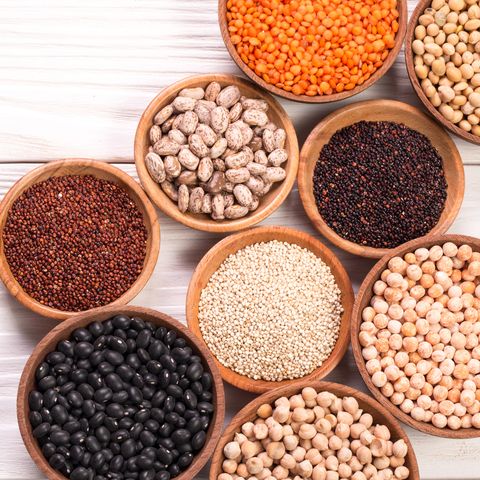A healthy diet should keep you fueled and energized — not feeling starved all day long. That's why a new approach to weight loss advocates the exact opposite of severely limiting calories, doling out carbs, or fasting intermittently. Instead, the satiating diet prescribes eating nutrient-dense foods that make you feel satisfied — while still losing weight if that's your goal.
Researchers at Université Laval in Quebec City, Canada, designed the eating plan to focus on vegetables, fruits, whole grains, and lean protein sources that will help fill you up. While traditional diet culture often overlooks satiety, getting in touch with your body's own cues is a great way to establish healthier eating habits for life, says Jaclyn London, MS, RD, CDN, Nutrition Director at the Good Housekeeping Institute.
"The structure focuses on what you can actively do to feel more sated by any meal or snack," she says. "That’s a great (and sadly, far less common!) attribute about this diet plan than some of the other types of 'new' weight-loss trends that are big right now. The language of the diet empowers people to make choices based on a structure that’s inclusive of real, wholesome foods — without forcing you to think too much about what you can’t have."
What is the satiating diet?
The satitating diet is an eating plan designed for lasting weight loss or maintenance without resorting to extremes. The diet recommends eating the following each day:
- 4 servings of whole vegetables
- 4 servings of whole fruits
- 5 servings of whole grains (with at least 4 g of fiber per serving)
- 4 servings of lean protein in each meal (or broken up into snacks)
- 1 snack
Additionally, the diet recommends having one legume-based meal per week and flavoring your food with more hot or red peppers. Eating spicy foods can slow you down as you eat, helping you stay mindful about when you feel full, London explains.
Overall, the nutrient breakdown for the satiating diet goes as follows:
- 45–50% of calories from carbohydrates
- 30–35% of calories from fat
- 20–25% of calories from protein
Because the plan advocates eating tons of produce, whole grains, and healthy fats (e.g., fish, nuts, seeds, eggs, and avocado), some people describe the satiating diet as a cross between the Mediterranean diet and the keto diet. The researchers behind the diet specifically recommend eating mono- and poly-unsaturated fats in moderate amounts and avoiding unhealthy trans-, hydrogenated, and saturated fats — the kinds you'd find in fried or processed foods.
However, the keto diet is only 10% or so carbohydrates, whereas this plan allows for about 50%. "I would call this more of a hybrid between the Mediterranean diet and a carb-controlled diet for diabetes management," London says.
Can the satiating diet help you lose weight?
The existing research done on the satiating diet looks promising for weight loss, but it's still in its early stages. As a preliminary test, Université Laval recruited 69 obese men to follow either the satiating diet or a control diet for 16 weeks. The control diet involved eating slightly more carbohydrates and less protein and fat per the Canadian national guidelines for healthy eating. At the end of the trial, the people following the satiating diet were not only more likely to stick to the plan, but they also lost on average more fat mass than those in the control group, according the 2017 study published in the British Journal of Nutrition.
"If the highly satiating diet proves to have the benefits we saw in our study and if it proves to be sustainable, it could be a realistic and potentially powerful dietary solution to the problem of weight control," Shirin Panahi, PhD, a postdoctoral researcher of physical education and kinesiology with Université Laval, wrote in Scientific American. This is the only study done on the satiating diet so far, though.
"There are a few things about the concept (and study design) that give me pause, the largest being the very small, limited sample size," London says. "I’m also not particularly keen on meal plans or programs that promote 'rules' instead of empowering you to make choices. But with that in mind, there are a few key takeaways that I think we could all benefit from."
What foods are the most satiating?
Satiating foods pack in lots of protein, fiber, and other nutrients that fill you up while nourishing your body. Those can include:
- Fruits: apples, oranges, bananas, oranges, peaches, pears, plums, pineapple, papaya, mango
- Vegetables: leafy greens, broccoli, Brussels sprouts, kale, cauliflower, squash, mushrooms, tomatoes, eggplant, avocado
- Whole Grains: brown rice, whole-wheat pasta, whole-grain cereals, oatmeal, quinoa, farro, buckwheat, bulgur, rye, barley
- Lean Protein: seafood, poultry, lean cuts of beef, eggs, milk, yogurt, cheese, nuts, seeds, tofu, soya, legumes, chickpeas, beans, peas, lentils
Flavor your foods with peppers of all types, plus herbs and spices like turmeric, ginger, garlic, and more.
How to Start a Satiating Diet
Recognizing satiety — as opposed to fullness — is key to losing weight, London says. It's basically the premise of her new book, Dressing on the Side (and Other Diet Myths Debunked).
"Eating to promote feelings of satiety is often much more important than eating to feel 'full,'" London says. "Some components of the diet (like eating spicy foods) are essentially tools that can help you get in touch with your own satiety cues and provide data about your physiological needs. That information is crucial to determine what, when, and why to eat from a place of self-awareness."
In addition to loading your plate with fruits, veggies, and other satiating foods, try using the "Satiety Scale," she advises. On a 1-10 scale, how satisfied do you feel before, during, and after eating a meal or a snack?
For example, 1 is "I just ran a marathon" and 10 is "I’m so stuffed I just ate an entire Thanksgiving turkey." Eat at around a 3–4, stop around 6–7, and aim for 5 as your satiety sweet spot as often as possible. Taking these three steps can also help you get in touch with satiety, London says.
- Use each meal or snack as an opportunity to think about how you feel, specifically your physical activity level, hydration status, and sleep. Did you have a super hard, super hot workout today? Did you sleep three versus eight hours last night? Are you thirsty?
- Think about what you might have "missed" at any meal: Did you order a bunless burger at lunch today and ultimately down a cereal box while watching TV later that night? Could you try adding in extra fiber to your lunch and see how you feel tomorrow? If you skip meals or skip satisfying components at a meal, you will likely overeat later on.
- Look for relationships between what you’re feeling when you’re eating. Take a moment to review when, where, and why you’re eating, and check in with physiological factors that might impact your hunger level today. Where you are and what you’re doing is just as important data as the foods that make you feel satiated. For example, if you think, I always reach for a snack when I’m stressed at the office, even just after lunch! Try a different form of stress relief, like a 15-minute walk to clear your head and reset.
https://www.goodhousekeeping.com/health/diet-nutrition/a27325569/satiating-diet/
2019-06-20 15:37:00Z
CBMiUGh0dHBzOi8vd3d3Lmdvb2Rob3VzZWtlZXBpbmcuY29tL2hlYWx0aC9kaWV0LW51dHJpdGlvbi9hMjczMjU1Njkvc2F0aWF0aW5nLWRpZXQv0gEA
Bagikan Berita Ini
















0 Response to "What Is the Satiating Diet and Can It Help You Lose Weight? - GoodHousekeeping.com"
Post a Comment